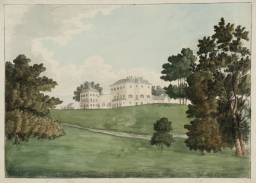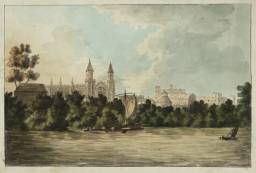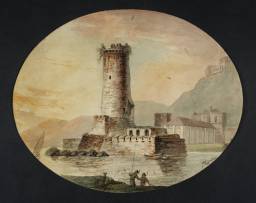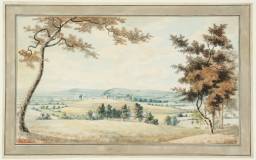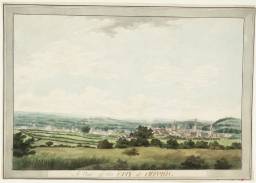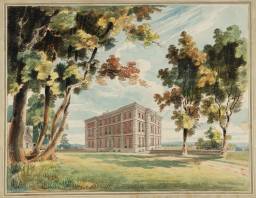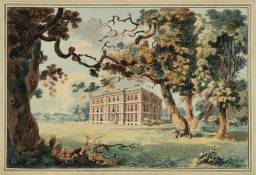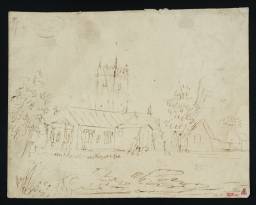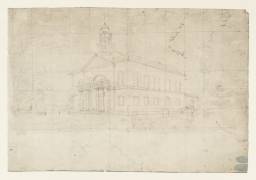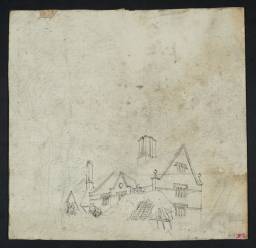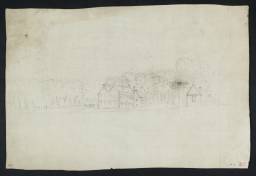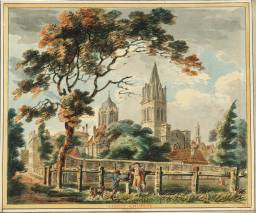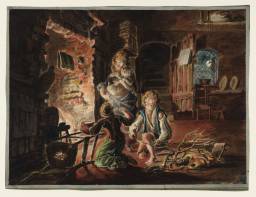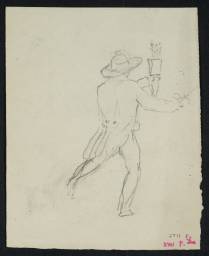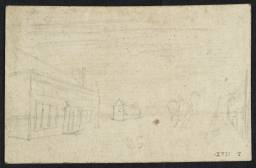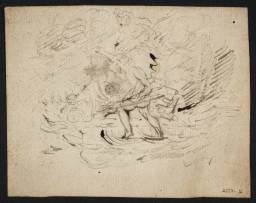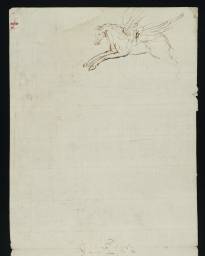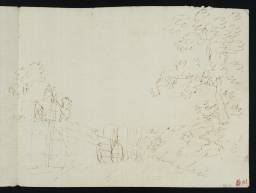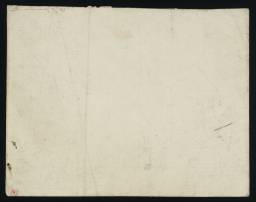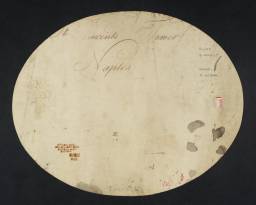Turner Bequest I A–C, E, III A–D, Ea–d, IV A–C, VIII A, XVII L, P, T, XXIX K
References
Turner’s earliest dated drawing is the 1787 view of Nuneham Courtenay (Tate D00002; Turner Bequest I B). Other works can be grouped round this, on the evidence of style. Some of the first essays in this group of watercolours and drawings are copies from prints, which exemplify a normal mode of self-tuition for any young artist of the time. Four finished watercolour views in Margate and Thanet, in a private collection,1 have been associated with his early recorded visits there at about the age of nine and eleven, but they are at least as sophisticated, in terms of draughtsmanship and the handling of perspective, as the Nuneham view, and it may be appropriate, as Youngblood has suggested (see under Tate D00047; Turner Bequest III B), to assign them to around 1787, i.e. when Turner was twelve.
The other drawings in this group display a steadily strengthening grasp of technique and colouring, though always within the strictly defined limits, and serving the clearly identified goals, of Turner’s self-imposed objective to become a topographical watercolourist. Joyce Townsend (1990) has identified the principal pigments in Turner’s palette at this time: indigo, gamboge, black, brown madder, vermilion, earth colours and an unidentified organic red occur in the views of Nuneham Courtenay (Tate D00002; Turner Bequest I B) and Radley Hall from the South-East (Tate D00049; Turner Bequest III D). At this early date he is unlikely to have been working on commission, but will have intended to display the finished views in his father’s shop window;2 hence the washline borders that he painted for several of the subjects, now largely trimmed away. A finished subject of this time which did not remain in Turner’s hands is a Distant View of Oxford from the South, which can be dated stylistically to 1789, in a private collection.3 This was not sold from his father’s shop but given to the Narraway family in Bristol with whom he sometimes stayed; see notes on the Bristol and Malmesbury sketchbook (Tate; Turner Bequest VI).
Notes follow below for five missing drawings of uncertain date (c.1787–91?) catalogued by Finberg. These drawings were presumably lost in the flood of 1928. Finberg grouped them with drawings dated approximately 1787, but they included the copy of St Vincent’s Tower, Naples which is probably a little later. The missing sheets most likely belong, however, to the years before 1792.
A House among Trees
Turner Bequest I I
Watercolour with ink outline on ?white wove paper, 149 x 200 mm
Literature:
A.J. Finberg, A Complete Inventory of the Drawings of the Turner Bequest, London 1909, vol.I, p.3, I I, as ‘House among Trees’
According to Finberg, ‘[t]wo corners torn’.
Turner Bequest I I
Watercolour with ink outline on ?white wove paper, 149 x 200 mm
Literature:
A.J. Finberg, A Complete Inventory of the Drawings of the Turner Bequest, London 1909, vol.I, p.3, I I, as ‘House among Trees’
According to Finberg, ‘[t]wo corners torn’.
Verso:
Inscribed in pencil ‘45. J.M.W. Turner, esq.’
Literature:
Finberg 1909, I, p.3, under I I, with transcription
J.P. Heseltine questioned (in a MS note) the surname in this inscription.
Inscribed in pencil ‘45. J.M.W. Turner, esq.’
Literature:
Finberg 1909, I, p.3, under I I, with transcription
J.P. Heseltine questioned (in a MS note) the surname in this inscription.
Dacre Castle
Turner Bequest I D
Turner Bequest I D
Watercolour with ink outline on?white wove paper (trimmed to an oval), 229 x 303 mm
Literature:
Finberg 1909, I, p.2, I D, as ‘“Dacre Castle.”’
Alexander J. Finberg, The Life of J.M.W. Turner, R.A. Second Edition, Revised, with a Supplement, by Hilda F. Finberg, revised ed., Oxford 1961, p.15
This subject is copied from an illustration to William Gilpin, Observations relative chiefly to Picturesque Beauty.... on several parts of England; particularly the Mountains and Lakes of Cumberland, and Westmoreland, 1786, vol.II, facing p. 85. Dacre is a fourteenth-century pele tower near the northern end of Ullswater. According to Finberg (1909), Turner had ‘introduced two figures of his own in the foreground’ of this copy. See also Tate D00008 (Turner Bequest I H).
Verso: blank; inscribed in ink ‘Daker Castle’
Literature:
Finberg 1909, I, p.2, under I D, with transcription
Finberg 1961, p.15
Literature:
Finberg 1909, I, p.2, I D, as ‘“Dacre Castle.”’
Alexander J. Finberg, The Life of J.M.W. Turner, R.A. Second Edition, Revised, with a Supplement, by Hilda F. Finberg, revised ed., Oxford 1961, p.15
This subject is copied from an illustration to William Gilpin, Observations relative chiefly to Picturesque Beauty.... on several parts of England; particularly the Mountains and Lakes of Cumberland, and Westmoreland, 1786, vol.II, facing p. 85. Dacre is a fourteenth-century pele tower near the northern end of Ullswater. According to Finberg (1909), Turner had ‘introduced two figures of his own in the foreground’ of this copy. See also Tate D00008 (Turner Bequest I H).
Verso: blank; inscribed in ink ‘Daker Castle’
Literature:
Finberg 1909, I, p.2, under I D, with transcription
Finberg 1961, p.15
A Bridge among Rocks
Turner Bequest I H
Turner Bequest I H
Watercolour on ?white wove paper (trimmed to an oval), 229 x 305 mm
Literature:
Finberg 1909, I, p.2, I H, as ‘Bridge among Rocks’
Finberg 1961, p.15
Like Dacre Castle (Turner Bequest I D, discussed above), copied with variations from William Gilpin, Observations relative chiefly to Picturesque Beauty.... on several parts of England; particularly the Mountains and Lakes of Cumberland, and Westmoreland, 1786, vol.II, facing p.227; the subject is a view in Dove Dale, Derbyshire, but a bridge and river were added to the design by Turner.
Verso: blank; inscribed in pencil ‘44’
Literature:
Finberg 1909, I, p.2, with transcription
Literature:
Finberg 1909, I, p.2, I H, as ‘Bridge among Rocks’
Finberg 1961, p.15
Like Dacre Castle (Turner Bequest I D, discussed above), copied with variations from William Gilpin, Observations relative chiefly to Picturesque Beauty.... on several parts of England; particularly the Mountains and Lakes of Cumberland, and Westmoreland, 1786, vol.II, facing p.227; the subject is a view in Dove Dale, Derbyshire, but a bridge and river were added to the design by Turner.
Verso: blank; inscribed in pencil ‘44’
Literature:
Finberg 1909, I, p.2, with transcription
A Frontier Bridge
Turner Bequest I G
Turner Bequest I G
Pencil on ?white wove paper, 235 x 378 mm; watermark ‘S. Lay’
Literature:
Finberg 1909, I, p.2, as ‘A Frontier Bridge’
Finberg 1961, p.15
Finberg (1909) describes this drawing as showing a ‘Rustic foot-bridge across river, with frontier posts on either side; the arms of Prussia on one of the posts.’ It was most probably copied from a print.
Verso: not noted by Finberg and presumably blank.
Literature:
Finberg 1909, I, p.2, as ‘A Frontier Bridge’
Finberg 1961, p.15
Finberg (1909) describes this drawing as showing a ‘Rustic foot-bridge across river, with frontier posts on either side; the arms of Prussia on one of the posts.’ It was most probably copied from a print.
Verso: not noted by Finberg and presumably blank.
Sheet of Sketches and Copies
Turner Bequest I F
Turner Bequest I F
Pencil on ?white wove paper, the paper folded in half, with each quarter drawn on, 270 x 419 mm
Literature:
Finberg 1909, I, p.2, as ‘The Old Kitchen at Stanton Harcourt, Oxfordshire ... (a) Two groups of figures; also a group of Knights fighting ... (b) Castle, with ruined wall ... (c) Old Kitchen, Stanton Harcourt ... (d) Tower, with ruined wall; also a group of figures’
Finberg 1961, p.15
Literature:
Finberg 1909, I, p.2, as ‘The Old Kitchen at Stanton Harcourt, Oxfordshire ... (a) Two groups of figures; also a group of Knights fighting ... (b) Castle, with ruined wall ... (c) Old Kitchen, Stanton Harcourt ... (d) Tower, with ruined wall; also a group of figures’
Finberg 1961, p.15
Side (a): Two Groups of Figures; a Group of Knights Fighting
Grose (see below) refers to a stained glass window in the chapel at Stanton Harcourt which showed the figures of knights, etc. The window was removed for purposes of preservation.
Grose (see below) refers to a stained glass window in the chapel at Stanton Harcourt which showed the figures of knights, etc. The window was removed for purposes of preservation.
Side (b): Castle, with Ruined Wall
Side (c): The Old Kitchen at Stanton Harcourt
Finberg (1909) supposed that this subject was copied from Francis Grose, The Antiquities of England and Wales, 2nd ed., vol.IV, facing p.187. The same view, with foreground figures, was engraved by W. Watts after Paul Sandby for A Collection of One Hundred and Fifty Select Views, in England, Scotland, and Ireland, 1781, pl.XLI, published 1 January 1778.
Finberg (1909) supposed that this subject was copied from Francis Grose, The Antiquities of England and Wales, 2nd ed., vol.IV, facing p.187. The same view, with foreground figures, was engraved by W. Watts after Paul Sandby for A Collection of One Hundred and Fifty Select Views, in England, Scotland, and Ireland, 1781, pl.XLI, published 1 January 1778.
Side (d): A Tower with a Ruined Wall; and a Group of Figures
Andrew Wilton, J.M.W. Turner: His Life and Work, Fribourg 1979, p.300 nos.1–4, reproduced (3 and 4), pls.1, 2 (1 and 2 respectively), as ?1784.
How to cite
Andrew Wilton, ‘Oxford and Other Subjects c.1787–91’, subset, April 2012, in David Blayney Brown (ed.), J.M.W. Turner: Sketchbooks, Drawings and Watercolours, Tate Research Publication, December 2012, https://www


